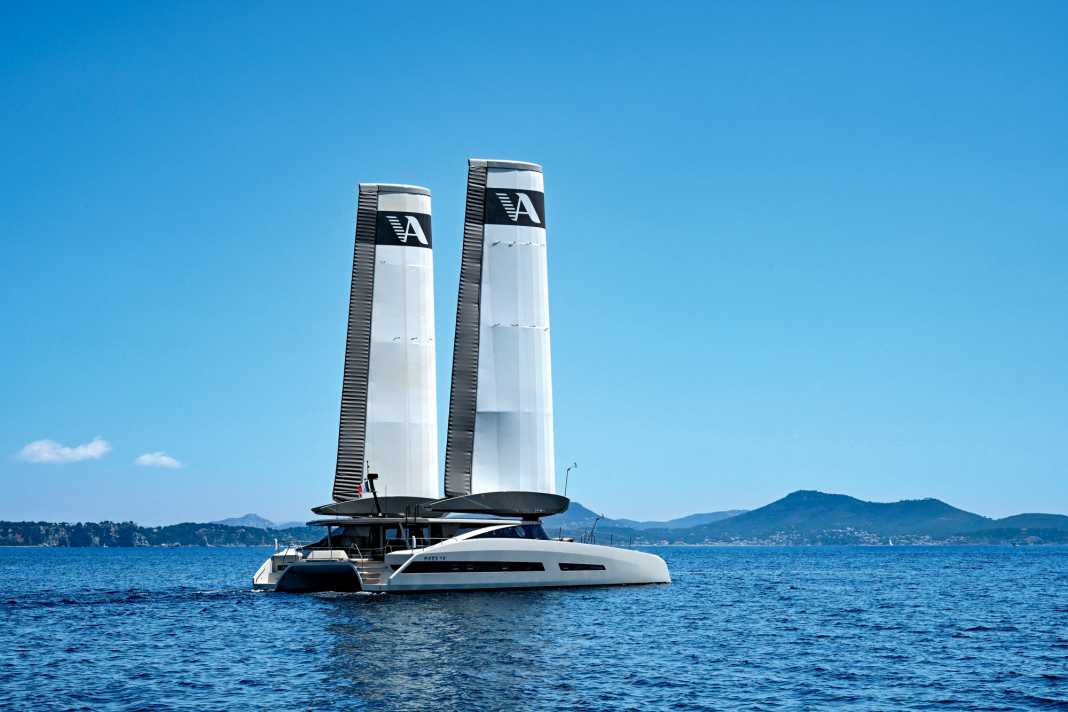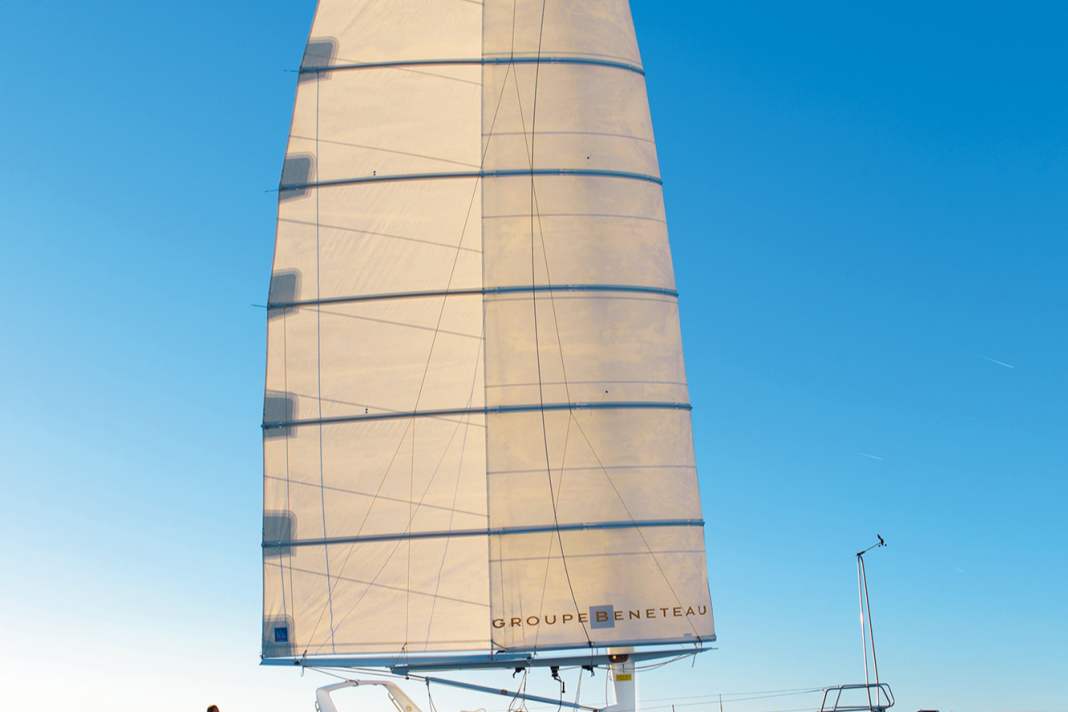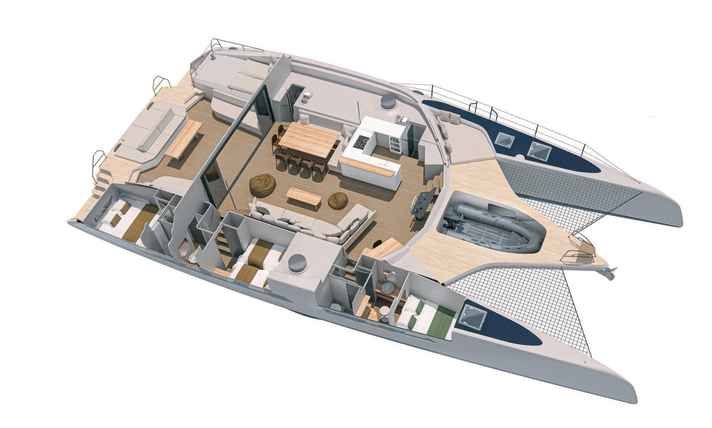MODX 70: When vision meets reality - a showpiece for sustainable yacht building






Ecological responsibility is no longer an option in the yacht building industry either, but is becoming increasingly urgent. Fossil-fuelled propulsion systems and environmentally harmful materials in the manufacturing process are no longer compatible with the requirements of a sustainable future. Manufacturers are called upon to react. Accordingly, the maritime sector is also in the middle of a certain transformation phase in this respect.
Also interesting:
Against this backdrop, the MODX 70 project presents itself as a radical alternative to the traditional concepts for ocean-going catamarans: a completely emission-free and energy-independent platform that has been planned from the ground up for climate-neutral blue water use. Large-scale solar panels, efficient hydrogen generation and intelligent energy management should enable self-sufficient operation, even over long distances and long periods of time. And without diesel drives, generators and carbon emissions.
Double inflatable wing rig
Behind this visionary concept is the small, highly specialised shipyard Océan Développement, based in Brittany. Since its foundation in 2008, the French company has made a name for itself with numerous extraordinary projects - including the construction of an offshore unit class with the high-performance trimaran MOD 70. With its commitment to the Race for Water project, the shipyard has also already actively campaigned for the protection of water and oceans. Another example of this is the solar-powered catamaran "PlanetSolar", which the shipyard has launched around the world as an innovative showcase platform and floating ambassador for climate protection. The Swiss Race for Water Foundation is now also involved in the new MODX 70 project. The aim is to position the ship as a flagship for sustainable developments.
There are no sheets or winches on board. The wing profiles are trimmed fully automatically by a computer.
The most visually exciting element on board the MODX 70 is the double inflatable wing rigs. The centrepiece of the system developed by Aeroforce is an asymmetrical wing profile with an actively controllable trailing edge - the so-called "flap". This structure, modelled on the flap of an aircraft, is moved electro-hydraulically. This allows the airfoil depth to be adjusted depending on the wind.
The wings themselves are made of a robust material and are built around a multi-part telescopic mast inside. When setting the sails, or rather wings, the masts are raised electrically and the wings are simultaneously inflated with powerful air pumps to an internal pressure of 100 millibars (0.1 bar). This may not seem like much, but it is enough to give the inflated wings amazing rigidity.
The wings are deflated and recovered in reverse order: the air is sucked out of the airfoils by the same pumps in reverse mode, while the masts are retracted at the same time. Gravity takes care of the rest. However, inflating and deflating the wings takes quite some time. In the prototype, both processes take an impressive eight minutes each. The manufacturers Océan Développement and Aeroforce are therefore working together on new systems to significantly speed up these processes.
All processes are carried out by electric motors
Because the two wings automatically align themselves with the apparent wind direction when rigging and unrigging, the catamaran does not need to stand in the wind during manoeuvres, but can take any course. The wings can be rotated 360 degrees as often as required in succession in the same direction of rotation. The electrical connections, for example to the fans, sensors or lighting in the top, are ensured via slip rings and sliding contacts. The technical solution is impressive.
Once the wings have been set, the central system computer takes over the trimming, depending on the course and wind. Without exception, all processes for adjusting the angle of attack and profile depth are carried out by a large number of electric motors. Because the efficient wings build up a lot of pressure even in light winds, a lot of torque is needed to adjust the rigs. Here too, the power comes from electric drives, which act on the rotating mast feet via a system of reduction gears. Unfortunately, YACHT was not allowed to take any photos of the extremely complex and technically sophisticated systems in the engine rooms.
Because the wings are always adjusted fully automatically to the wind direction while underway, there is not much for the crew to do - apart from listen to the drive noises of the numerous electric motors, which can be quite intrusive in the long run. The skipper can steer if he wants to, but he could just as easily leave the work to the autopilot, which is also linked to the on-board computer and finds the optimum course for the wind direction on its own.
Manual work at the helm is only necessary during manoeuvres. When jibing, the aft edge of the wings is turned over the bow to prevent the profiles from suddenly flipping in windy conditions. However, as the rigs rotate slowly - a complete rotation takes around one and a half minutes - the helmsman must pay attention to the position of the wings both when tacking and jibing and steer the boat through the manoeuvres accordingly.
Full performance on all courses
And then there's the matter of the ominous lever on the helm. This is a kind of redundancy knob that the helmsman can use to manually turn the two wings away from the optimum position if necessary. It's a bit like fiddling the sheets on a conventional rig, for example in high winds and strong gusts or if you want to slow down the speed in general.
For the sailing tests off Toulon, the lever remains at the 100 per cent mark - full power. In winds of only around eight knots, the winged cat achieves a speed of around six knots on all courses, whether crosswind, downwind or downwind. The project managers report on tests in stronger winds, where the prototype is said to have reached speeds of up to 16 knots. Incidentally, numerous pressure sensors report when the pressure on the profiles becomes too high in strong winds. In this case, the wings can be reduced by half their surface area, i.e. reefed - at the touch of a button, of course.
Extensive self-sufficiency with the MODX 70
The Aeroforce rigging system with its many mechanisms and digitally controlled trim functions is a clear commitment to technical sophistication. However, this comes at a price in the form of a not inconsiderable power requirement. While conventional rigs use muscle power, winches and sheets to trim the sails, the fully automated systems on the MODX 70 require a lot of power and are therefore dependent on a stable and powerful energy supply.
The technology is extremely complex and elaborately installed. A lot of development work has gone into the wing rigs in particular.
This takes place on board via two complementary systems: Solar panels covering a total area of 70 square metres are installed on the flat roof of the cabin superstructure and on the foredeck. They feed in around 35 per cent of the energy required when the sun is shining. The two electric motors, which run alongside the boat and switch to recuperation when travelling at around ten knots, work more efficiently. The propellers generate several kilowatts of charging power. This is enough to generate a permanent surplus of energy when travelling at sufficient speed and thus ensure far-reaching self-sufficiency.
Of course, they don't come for free: the rotating propellers generate a lot of resistance at the expense of the boat's speed. A good knot of speed is lost with this form of hydrogeneration. Two huge lithium-ion battery banks with a total capacity of 250 kilowatt hours are available on board to buffer the energy generated. This corresponds to around 2.5 times the energy content of a Tesla battery.
MODX 70 is not a mass product, but a source of inspiration
All in all, the MODX 70 is a fascinating and visionary project - a showpiece for sustainable yacht building that can set standards in many respects. With its consistent approach and emission-free drives, the cat shows what is possible in modern yacht building today. The innovative wing rig impresses with its efficiency and technical maturity. And it emphasises the claim of breaking new ground - even if the extremely high energy requirement compared to a conventional rig certainly raises questions about long-term self-sufficiency and whether it makes sense.
Whether this concept can establish itself on the market in the long term remains uncertain. However, initial facts speak in favour of it. A second boat has been ordered by a private owner and is already under construction. There are also apparently numerous enquiries for a smaller version with a similar design. The shipyard wants to pursue these interests and is already working on the realisation.
With a price tag of around eight million euros, the MODX 70 is not a mass product - but it is one of many trendsetters for sustainability in yachting.
Evolution or revolution?



The idea of replacing the conventional high rig with profiled, flexible wing sails is not new. There have been numerous approaches in the past, but none of them have been able to establish themselves as a serious alternative in the long term. Around ten years ago, Beneteau was working on a "wing rig for everyone". The industry leader wanted to develop a safe and particularly easy-to-use rig for touring sailors and beginners. The idea for the "Inflated Wingsail" (IWS) came from the Swiss Edouard Kessi, who also worked as a consultant on the MODX 70 project. His idea was for the wing to align itself automatically with the wind and not have to be actively trimmed. The patent was later further developed and sold for use on cargo ships.
Technical data MODX 70

- Design engineer: VPLP/Aeroforce
- Torso length: 21,33 m
- Width: 10,00 m
- Depth: 2,00 m
- Mast height above WL: 23,0 m
- Weight: 30,0 t
- sail area: 2 x 125 m²
- Motorisation: 2 x 20 kW
- Battery bank capacity: 250 kWh

